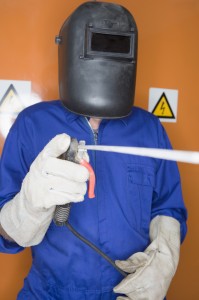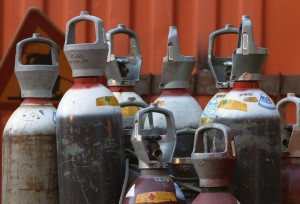Too often, one looks at the use of consumables in welding as a cost of doing business. After all, they’re bound to get used up eventually. However, there is a balance between the wise use of welding consumables and obsessive-compulsive micromanagement. Knowing how best to manage the consumables in your shop will lead to savings and less waste.
Proper storage:
“Improper storage can lead to porosity, elevated diffusible hydrogen levels, poor weldability, and rust,” says Lisa McFadden, Product Manager – Consumables at Lincoln Electric. “Store indoors at up to 70 per cent relative humidity. Protect from the weather or other adverse conditions. Packages should be stored under conditions that minimize the likelihood of temperature variations that cause moisture condensation on the consumables. Ensure packaging is intact until ready to use. Use first-in first-out inventory rotation principles.”
wher some shops will store their consumables in an out of the way corner of the plant, this is not an ideal solution according to Jose Luis Bermudez NA Product Business Manager – Solid Wire from ESAB’s Technical Team at the Guadalajara, Mexico office. “The proper storage is a location, clean, free of dust and dirt, and [without] changes in temperature. Most important, avoid direct contact with floor and walls. It is obvious that temperature control is one of the aspects that most people recognize.”
Improper storage of consumables will lead to problems on the shop floor with bad welds and defective products. “Improper storage can cause damage to the wire or stick electrode that leads to quality issues within the weld. These quality issues cause downtime for rework and increase costs for labour that is not contributing to the productivity of the welding operation,” said Bruce Morrett, product manager, solid wire and stick electrode division, Hobart Brothers. “Damaged consumables also need to be thrown away and they typically void manufacturer’s warranties, so companies not only lose money for product they can’t use, but also for purchasing new consumables.”
There is no difference if it is a small shop or a large plant. “Wires that have been used on an application should be covered securely with a plastic bag if left on the wire feeder, or ideally removed and stored in the original box in an appropriate area. Stick electrodes should also be kept in a clean, dry area, and reconditioned per the manufacturer’s recommendation should they encounter moisture,” said Morrett.
Having an inventory system that tracks welding consumables will eliminate the danger that old stock does not go to waste. “It is also important to work under a FIFO methodology (First In, First Out),” said Bermudez. “Avoid keeping old material in stock.”

The stick situation:
Although it can be minimized, there will always be waste when using stick welding. “With stick electrodes (also called welding rods), the entire length cannot be used, resulting in anywher from two to eight inches of stick electrode that is thrown away. Stub loss is part of the nature of the process, since welders can only weld with so much of the stick electrode,” said Morrett. “The higher amount of stub loss typically occurs in applications in which the welder bends the stick electrode to reach into a restricted joint, such as a boiler tube application. Sometimes poor arc initiation or ‘sticking’ the electrode can cause the coating to crack, resulting in the loss of entire electrode. Improper storage or reconditioning, especially on code jobs, requires the stick electrodes to be disposed of and leads to greater waste.”
Ideally sticks should be burned down to about a two-inch stub. “Not burning the electrode down to a short (two-inch) stub leads to waste,” said McFadden. Getting back to proper storage, “leaving the rods exposed to the atmosphere for an excessive length of time leads to moisture pick-up,” she said. Rods which have been exposed to the elements should be rebaked and not scrapped said McFaadden.
Save the wire:
Loading a wire feeder can be tricky, especially for the novice. Most of us have seen the wasteful birdcage that is created when a carelessly opened wire spool springs open. This however is not the only cause of waste. “Welders typically clip the end of the wire to help improve arc initiation. Excessive clipping could result in waste of the welding wire,” said Morrett. “Improper wire feeder set-up can also cause ‘overrun’ of the wire, allowing too much wire to feed out of the GMAW gun and requiring the welder to clip the excess amount. In some cases, the wire may come loose from the spool (usually due to poor manufacturing processes) and cause the wire to spin free; this remaining wire will typically be thrown away. On jobs with code requirements, consumable waste can occur if wire is left on the wire feeder for too long; it will need to be thrown away after a given period of time. Similarly, improper storage can lead to damage that renders the wires unusable and welders must dispose of them.”
Improper setting can also lead to not just waste of the wire, but to bad parts and loss of production. “The number one waste in the GMAW or FCW process could be related to the excessive use of shielding gas,” said Bermudez. “However, there are many variables in this process that must be carefully reviewed, from the correct parameter setting to avoid excessive spatter to the healthy condition of drivers and feedrolls, to prevent continuous stops in the process.”
 The gas issue:
The gas issue:
The most likely cause of waste with shielding gas is leaks in the system. These can be hard to notice and even harder to trace and mend. “Excessive gas to the gun, regulators and guns in poor condition,” are other reasons for shielding gases to dissipate before their use. “For GMAW/FCAW process, using gas savers should be considered. Depending on the condition, the a gas saver device can provide savings up to 30 per cent from the current cost.”
Automation questions:
Automation is usually trumpeted as the saviour to all the problems but with waste in the work place it might not be so. “Automation typically uses bulk packaging. This can reduce the amount of partial spools that are potentially thrown away common in semi-automatic welding,” said Lincoln’s McFadden. “However, with bulk packaging, recommended exposure time may be exceeded before the package is used up. Therefore, bulk packaging should only be used in higher volume applications.” Morrett agrees stating, “In some cases it can, but the reduction is not huge. Typically, robotic welding applications use larger drums of welding wire, so there is less changeover of packaging and potentially less wire waste at the end of a drum (i.e. in comparison to multiple smaller spools).” Bermudez adds, “Automation is a good option only when the volume of the production is high. At this point the investment on automation equipment will make sense. Waste is reduced because a robot will only apply the amount of filler metals necessary according to a program. The savings come also from the reduced labour cost as well as reduced down time.”




